Intelligent Clothes
Like everything else, high tech is the way the apparel sector is growing too. From key functional benefits across health, wellness, sports, protection to fashion and everyday comfort, ‘smart garments’ is the new buzz word of the sector. Dr Noopur Anand walks us through the new vistas…
I celebrated 30 years of Back to the Future, the remarkable 1985 Zemeckis-Spielberg film by buying the DVDs and screening all three of them back-to-back for my kids last month. I enjoyed it as much as I did 30 years ago, but something that struck me was that so many of the fantasy and futuristic concepts and gadgets shown in the films have already turned into reality and are a part of our everyday lives. Wireless video games, handled tablet computers, wall mounted wide screen televisions, video conferencing – we have it all. However, my favorite – the Hover Boards – are still not a reality though I am told that the prototypes are already in place and are successful. Wow, I am actually living the future!
It’s true that the pace of technological advancement and innovation has been highest in our lifespan than ever in human history. It has completely changed the way we communicate, travel, exchange information, eat, live and drink. It’s no wonder that its changing the way we dress and clothe ourselves.
Among all the things that intrigued me, I was most interested in Marty’s (Michale J Fox’s character in Back to The Future) auto adjustable jacket and power lacing shoes and lo behold, these are almost a reality too. Nike has confirmed that it is releasing Marty’s self-lacing, light-up sneakers from Back to the Future to the public very soon.
Fitness Wearables
Last year we saw increasing popularity of fitness wearables, Apple Watch, Fitbit wristbands, Polar fitness monitors etc. As per Gartner, 2015 will see the preference of fitness wearable shift away from the wrist wears to smart garments with a jump from 0.1 million global shipments in 2014 to over 26 million by 2016, which makes smart garment a very promising sector for retail markets worldwide including India.

Smart garments are being designed with features for both functional and aesthetic end uses. Functional smart garments help monitor health, enhance performance and contribute to improving the quality of daily life of the wearer. The aesthetic smart garments create greater interest by changing color, shape and some even depict the mood of an individual.
Use in Healthcare Industry
Smart garments have a huge impact on the healthcare industry through functions of monitoring, recording and regulating.
Smart Medical Shirts: They allow comfortable measuring and/or monitoring of individual biometric data, such as heart rate, respiration rate, body temperature, and caloric burn. This biometric information is wirelessly transmitted through Internet to experts, where it is analyzed and then sent to the physician.

Many companies are commercially manufacturing these smart medical garments like Life Shirt developed by VivoMetrics California, D Shirt by Cityzen Sciences France, and Smart Shirt by Georgia Institute of Technology. Also, some smart shirts are made for specific needs of patients like the ‘Liquid Accumulation Vest’ by Clothing+ , fabricated by a Finland based company, which measures water accumulation in the lungs to indicate heart condition and helps patients to follow treatment regime and adopt positive lifestyles
Use in Healthcare Industry
Smart Infantwear: Smart infantwear could help prevent Sudden Infant Death Syndrome (SIDS) commonly known as “cot death”. The garment monitors babies during sleep and has special sensors to monitor baby’s heartbeat, respiration, sleep status, breathing and body position. It also allows parents to listen in on the baby and can have text message alerts sent to a parents.

Some such garments are Mamagoose Pajamas by Belgian company Verhaerth Design and Development and the University of Brussels (VUB), Exmobaby by Exmovere (Virginia, United States), The Mimo Smart Baby Suit (Boston USA), and Owlet Baby Care Sock by Brigham Young University. Additionally, there are separate monitors which could be attached to baby clothing for data collection and sharing with parents like MonBaby from MonDevices (NewYork), etc.
Use in Healthcare Industry
Smart Bra: Scientists at the University of Wollongong in Australia are developing a ‘Bionic Bra’, a smart bra that will change its properties in response to breast movement, giving better support to active women. Smart Bra will tighten and loosen its straps, or stiffen and relax its cups, to restrict breast motion thus preventing breast pain.

Professors at the Centre for Materials Research and Innovation (CMRI) at the University of Bolton are developing a cancer detecting bra.
Smart Underwear: Royal Society of Chemistry reported that US scientists have developed Biosensor underwear wherein biosensors can be printed directly onto clothing to allow continuous monitoring of blood pressure and heart rate outside hospitals.
Smart Maternity belts: Cornell university is exploring the concept of a pregnancy health tracking belt wherein, the conductive silver fiber woven into the fabrics will track the health metrics like heart rate, temperature, breathing, blood pressure of the mother and send the same to a doctor.
Use in Fitness Industry, Sports & Athletics
 Smart garments have monitoring features to give real time data feed to sports people to better plan, regulate and control workouts hence increasing performance and preventing injury.
Smart garments have monitoring features to give real time data feed to sports people to better plan, regulate and control workouts hence increasing performance and preventing injury.
Use in Fitness Industry, Sports & Athletics
Performance Enhancing Smart T-Shirts: These T-shirts have several sensors woven into a them to record some or all the Biometric data like heart rate, breathing rate and volume, steps, pace, calories burnt, intensity of the movements in workout, muscles usage patterns during workout, etc. The recorded data can be manipulated on an app through a smart phone or tablet to help the sportsperson to get most out of their workout and prevent injury. Some of these products are made in compression suits which actively helps with blood circulation and muscle recovery. Some such commercially available garments are Hexoskin (US), Polo shirts from Ralph Lauren (US), OM Smart Shirt (US), Athos (US), DShirt (France), Gymi Smart Shirt (Australia), Rshirt (France) Xsensio, (Switzerland), etc.

Use in Fitness Industry, Sports & Athletics
Smart Socks, Shorts & Bras: In the same category, there are socks, shorts and bras also available which record the required data for improved performance. For example: MBody Bike & Run (Germany) are muscle sensing smart shorts that help runners and cyclists to have knowledge of their muscle activity and help them to improve their technique and minimize injuries.

Sensoria running socks which track runs in detail, offering information on pace, distance and time as well as pressure placed on the foot during running which helps users run faster and in better form and also reduced risk of injury.
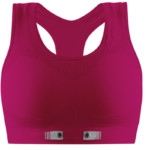 Numetrex heart sensing bra is commercially available heart rate monitoring apparel which makes real time data available for the active women to make workouts more efficient and effective.
Numetrex heart sensing bra is commercially available heart rate monitoring apparel which makes real time data available for the active women to make workouts more efficient and effective.
Performance can also be increased by making the sports person comfortable which was the thought behind the development of Climachill by Adidas. The line incorporates titanium and 3D aluminum cooling spheres which provide an instant chilling sensation to help athletes’ in warm conditions – lowering their body temperature so they can train harder, run longer, retain their focus and compete at the highest level.
Use in Fitness Industry, Sports & Athletics
Smart Shirts for Coaching: Heddoko (US) has developed a compression suit embedded with sensors which captures movement in 3Dimensions and analyzes it. The data is a training aid to professional sportsperson and coaches.

A similar product called ‘Swing monitoring Jacket’ is also being developed by US scientists from the Royal Society of Chemistry which will monitor swing for hockey and golf players helping the coaches to get insight on which muscles are engaged during the swing to coach the sports person accordingly.
Damage Prevention Smart Garments
Smart garments not only enhances performance but also prevent injuries. For example: Visijax commuter jacket and inflatable vest called Spidi airbagtype and Hit Air jacket developed by an Australian company enhances the safety of motorcyclists. The jacket has air cushion system which inflates as the rider falls from bike providing impact protection to the neck, shoulders and back. The jackets can also be used for power sports and horse riding.

Much work has also been undertaken for protection of Skiers like ‘Heated Ski Jackets and accessories’ which are manufactured by many companies in the US, UK, and Germany. These heated clothing items for skiing like heating gloves, heating helmet, heating ear pads, heating undergarments, etc., keep the wearer warm in cold temperatures preventing snow based health complications.
Philips, the electronics giant, is also looking into development of Life-Saving Ski Jacket that has a built in thermometer, GPS, and proximity sensor. The thermometer monitors the skier’s body temperature and heats the fabric if it detects a drastic fall in the body temperature. The GPS locates the skier, and the proximity sensor tells the skier if other skiers are nearby.
Another such product called ‘Adaptive Survival Clothing’ is being developed by Jacqueline Nanne of Wearable Senses, a research unit of the Eindhoven University of Technology, which is a weather adapting sweater. The sweater is composed of three layers. The ‘inner’ is the base of the garment, and it responds to the body temperature (fabric opens when you are exercising, and closes when you are resting); the ‘middle’ is the insulating layer and the only one that is not thermoregulatory, the ‘outer’ which adapts to climate changes (the fabric opens when the weather is nice and vice versa).
Use of Smart Garments in Every Day Life
Solar paneled jackets developed by Tommy Hilfiger with solar company Pvilion can power phones, ipods, smart watches, etc. Another example is a jacket with ‘e-Blocker’ fabric which absorbs almost 100 per cent of the electrosmog produced by the mobile phone hence protecting the wearer from phone radiations.

A Hugging Jacket developed by T.Ware, a Singaporean company which has airbags in the vest to simulate a hug. The accompanying smartphone app allows person to give a “hug” from anywhere.
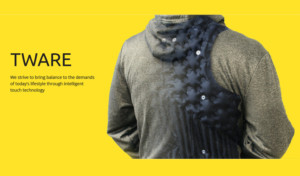 The jacket allows varying levels of pressure to be applied to different parts of the body, creating a more personalized form of physical interaction. The jacket has now been modified to have another end use i.e. ‘Massage Jacket’ to provide targeted point pressure on the upper and lower back with a rhythmic massage to the wearer anytime.
The jacket allows varying levels of pressure to be applied to different parts of the body, creating a more personalized form of physical interaction. The jacket has now been modified to have another end use i.e. ‘Massage Jacket’ to provide targeted point pressure on the upper and lower back with a rhythmic massage to the wearer anytime.
Asthetic End Use of Smart Garments
Underneath Clothes are being designed using smart technology which will change color as per the wearer’s mood or environment. Designer Lauren Bowker of UK has designed a range of ‘Color Change’ garments which has a EEG equipped headband which will change color at will i.e., grey for the office, and a red for cocktails in the evening.

Bowker developed an ink which can detect changes in air quality, heat, moisture, and UV light and clothes made with it will switch colors depending on the environment.
Concordia University in Montreal has also developed the Karma Chameleon dress which can change shape and color according to the wearer’s movement, taking energy from the body.
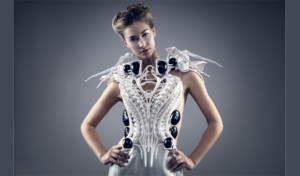 Dutch designer, Anouk Wipprecht has constantly experimented with technology to create interesting designs. She designed 3D printed smart dress called Synapse Smart Dress which is powered by Intel’s Edison chip and measures all sorts of things with biosensors and reacts in different ways. It displays the concentration and focus of the wearer, a proximity sensor sets off LEDs if someone gets too close, a camera on the front can capture which objects or people are affected by the mood of the wearer.
Dutch designer, Anouk Wipprecht has constantly experimented with technology to create interesting designs. She designed 3D printed smart dress called Synapse Smart Dress which is powered by Intel’s Edison chip and measures all sorts of things with biosensors and reacts in different ways. It displays the concentration and focus of the wearer, a proximity sensor sets off LEDs if someone gets too close, a camera on the front can capture which objects or people are affected by the mood of the wearer.
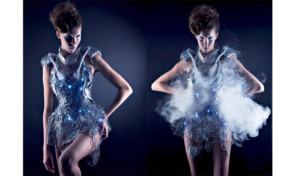 The same designer has also made ‘Smoke Dress’ and ‘Intimacy Dress’ in the past and her newest development is ‘Spider Dress’. This dress is a 3D-printed experimental dress crowned at the collar with robotic spider legs. The legs constantly move, reacting to real-time biometrics based on pre-programmed social norms and are assistive and adaptive to the owner’s emotions and desires.
The same designer has also made ‘Smoke Dress’ and ‘Intimacy Dress’ in the past and her newest development is ‘Spider Dress’. This dress is a 3D-printed experimental dress crowned at the collar with robotic spider legs. The legs constantly move, reacting to real-time biometrics based on pre-programmed social norms and are assistive and adaptive to the owner’s emotions and desires.
Where the Synapse Dress measured EEG brain activity and heart rate in real time, Spider Dress uses proximity and breathing. Smart garments are ever evolving and are slowly but surely finding their way in every aspect of human life. They perform the function of providing comfort, enhancing performance and safety and soon will be interacting with immediate environment and provide protection and guidance to the owner.
The most exciting development which is ongoing is in the field of ‘Wearable drones’. Well, even Spielberg and Zemeckis did not think of these in their Back to the Future franchise. In future drones can be companions, friends and assistants to human race. They can be attached to the garments and can come in action in case of need.
An under development concept drone called ‘Breathe’, has pollution sensor and filter and could hover in front of owners mouth and nose, cleaning the air they breathe when pollution levels are high otherwise it sits passively on the shoulder of the owner’s jacket.
‘Flare’, a personal guide, when deployed, scouts for the better routes and guides its owner in an unfamiliar city, pointing out interesting sites along the way. ‘Parasol’, a drone act as a personalized weather drone and if it detects impending precipitation or high levels of ultraviolent radiation, it could morph into a protective gear (like an umbrella) to shield its owner from harm.
Google & Levis to Develop Wearable Technology
Google announced its cooperation with Levi’s to design wearable technology. Project Jacquard launched by both will create by weaving touch-pad style capabilities into the fabric.

The new technology would enable people to make phone calls and send messages just by swiping their clothes. Items like jeans, sweaters, jackets, carpets and even furniture could potentially be turned into an interactive device, to be used like a track pad or button, according to Google’s Advanced Technology and Projects (ATAP), which is in charge of the development.
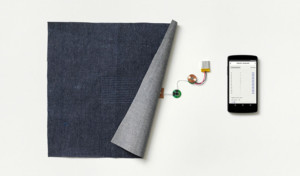 New thread types used for the material can be woven into any shape, size or pattern and be made either to stand out or be invisible. The interactive material would be able to understand various gestures like crossing your legs or swiping your sleeve with your fingers.
New thread types used for the material can be woven into any shape, size or pattern and be made either to stand out or be invisible. The interactive material would be able to understand various gestures like crossing your legs or swiping your sleeve with your fingers.
 The special fabric would also be capable of sending the data wirelessly to smartphone and other devices, opening up an array of new types of applications, aside from the most basic communication commands like placing a phone call and sending a text message.
The special fabric would also be capable of sending the data wirelessly to smartphone and other devices, opening up an array of new types of applications, aside from the most basic communication commands like placing a phone call and sending a text message.



